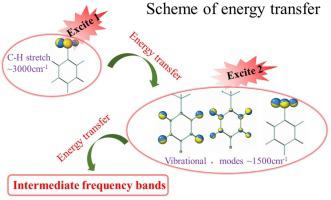Vibrational Spectroscopy ( IF 2.7 ) Pub Date : 2021-09-04 , DOI: 10.1016/j.vibspec.2021.103296 Xiaosong Liu 1, 2 , Weilong Liu 2 , Zhongyuan Yuan 1 , Wei Zhang 2

|
Selective excitation of the high-frequency C H stretching vibrational modes around 3000 cm−1 and the low-frequency vibrational modes around 1500 cm−1 of toluene in the narrow femtosecond time- and frequency-resolved CARS spectrum induces the transfer of the intramolecular vibrational energy from the vibrational modes in the selectively-excited region to the vibrational modes outside the excitation region. The vibrational energy transfer from high-frequency parent modes (vibrational modes are selectively excited by pump and Stokes laser pulses) to low-frequency daughter modes (vibrational modes are indirectly excited by energy transfer) via vibrational coupling and the dynamic information of vibrational modes involved in coupling are identified by fast Fourier Transformation (FFT) analysis. The lifetime of the vibrational modes is described, and the energy transfer pathway is confirmed. When the majority of toluene vibrational modes are collectively excited in the multiplex femtosecond time- and frequency-resolved CARS, the vibrational coupling information can be traced from the time-domain CARS spectrum and its frequency-domain FFT power spectrum. Vibrational energy transfer cannot be detected in the multiplex CARS spectrum of toluene. According to experimental results from the selective excitation CARS spectrum and multiplex CARS spectrum, the selective excitation CARS spectroscopy is an efficient method to track intramolecular vibrational energy transfer from parent modes to daughter modes and identify the energy transfer pathway.
H stretching vibrational modes around 3000 cm−1 and the low-frequency vibrational modes around 1500 cm−1 of toluene in the narrow femtosecond time- and frequency-resolved CARS spectrum induces the transfer of the intramolecular vibrational energy from the vibrational modes in the selectively-excited region to the vibrational modes outside the excitation region. The vibrational energy transfer from high-frequency parent modes (vibrational modes are selectively excited by pump and Stokes laser pulses) to low-frequency daughter modes (vibrational modes are indirectly excited by energy transfer) via vibrational coupling and the dynamic information of vibrational modes involved in coupling are identified by fast Fourier Transformation (FFT) analysis. The lifetime of the vibrational modes is described, and the energy transfer pathway is confirmed. When the majority of toluene vibrational modes are collectively excited in the multiplex femtosecond time- and frequency-resolved CARS, the vibrational coupling information can be traced from the time-domain CARS spectrum and its frequency-domain FFT power spectrum. Vibrational energy transfer cannot be detected in the multiplex CARS spectrum of toluene. According to experimental results from the selective excitation CARS spectrum and multiplex CARS spectrum, the selective excitation CARS spectroscopy is an efficient method to track intramolecular vibrational energy transfer from parent modes to daughter modes and identify the energy transfer pathway.
中文翻译:

选择性激发CARS光谱:一种分析振动耦合和分子内振动能量转移的有效方法
 3000 cm -1附近的高频 C H 伸缩振动模式和 1500 cm -1附近的低频振动模式的选择性激发在狭窄的飞秒时间和频率分辨 CARS 光谱中甲苯的吸收诱导分子内振动能量从选择性激发区域的振动模式转移到激发区域外的振动模式。振动能量从高频母模(振动模由泵浦和斯托克斯激光脉冲选择性激发)到低频子模(振动模由能量转移间接激发)通过振动耦合和所涉及的振动模的动态信息传递通过快速傅立叶变换 (FFT) 分析识别耦合中的 。描述了振动模式的寿命,并确定了能量传递路径。当大多数甲苯振动模式在多路飞秒时间和频率分辨 CARS 中集体激发时,振动耦合信息可以从时域 CARS 谱及其频域 FFT 功率谱中追踪。在甲苯的多重 CARS 光谱中无法检测到振动能量转移。根据选择性激发CARS光谱和多重CARS光谱的实验结果,选择性激发CARS光谱是跟踪分子内振动能量从母模到子模的转移并识别能量转移途径的有效方法。在甲苯的多重 CARS 光谱中无法检测到振动能量转移。根据选择性激发CARS光谱和多重CARS光谱的实验结果,选择性激发CARS光谱是跟踪分子内振动能量从母模到子模的转移并识别能量转移途径的有效方法。在甲苯的多重 CARS 光谱中无法检测到振动能量转移。根据选择性激发CARS光谱和多重CARS光谱的实验结果,选择性激发CARS光谱是跟踪分子内振动能量从母模到子模的转移并识别能量转移途径的有效方法。
3000 cm -1附近的高频 C H 伸缩振动模式和 1500 cm -1附近的低频振动模式的选择性激发在狭窄的飞秒时间和频率分辨 CARS 光谱中甲苯的吸收诱导分子内振动能量从选择性激发区域的振动模式转移到激发区域外的振动模式。振动能量从高频母模(振动模由泵浦和斯托克斯激光脉冲选择性激发)到低频子模(振动模由能量转移间接激发)通过振动耦合和所涉及的振动模的动态信息传递通过快速傅立叶变换 (FFT) 分析识别耦合中的 。描述了振动模式的寿命,并确定了能量传递路径。当大多数甲苯振动模式在多路飞秒时间和频率分辨 CARS 中集体激发时,振动耦合信息可以从时域 CARS 谱及其频域 FFT 功率谱中追踪。在甲苯的多重 CARS 光谱中无法检测到振动能量转移。根据选择性激发CARS光谱和多重CARS光谱的实验结果,选择性激发CARS光谱是跟踪分子内振动能量从母模到子模的转移并识别能量转移途径的有效方法。在甲苯的多重 CARS 光谱中无法检测到振动能量转移。根据选择性激发CARS光谱和多重CARS光谱的实验结果,选择性激发CARS光谱是跟踪分子内振动能量从母模到子模的转移并识别能量转移途径的有效方法。在甲苯的多重 CARS 光谱中无法检测到振动能量转移。根据选择性激发CARS光谱和多重CARS光谱的实验结果,选择性激发CARS光谱是跟踪分子内振动能量从母模到子模的转移并识别能量转移途径的有效方法。











































 京公网安备 11010802027423号
京公网安备 11010802027423号